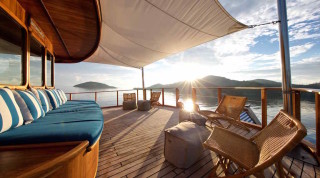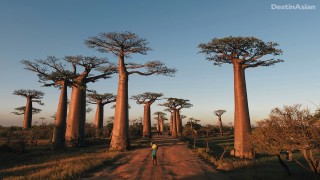Above: Taking in the alpine scenery from Chilai Ridge.
Trekking Chilai Ridge requires preparation and care, but the reward is one of Asia’s finest treks.
By Brent Hannon
Photographs by Alberto Bozzola
In retrospect, the Manila Pub in downtown Taipei was probably not the best place to plan our trip to Chilai Ridge, a formidable range of peaks that offers one of the toughest treks in Taiwan. Wrapped in the Manila’s warm embrace, the five of us drank gin-and-tonics and dreamed up a list of gourmet provisions—Thai curry and spaghetti marinara, Italian salami and pecorino cheese—to bring along. We cheerily calculated how much beer and whiskey we could carry. But amid the clink of cocktail glasses and the swirl of bonhomie, there was little talk of tents or stoves or sleeping bags, and no mention at all of the weather.
Mostly forgotten was Chilai Ridge itself, an undulating moonscape of tenuous handholds, shaky rope ladders, and sudden storms—a high-altitude hike that is unrivaled in beauty, yet infamous for chewing up and spitting out unprepared backpackers. In other words, folks just like us.
Nonetheless, two days later we were at the trailhead in Taroko National Park, our packs groaning with food and gear, staring soberly at a notice that was posted there. complicated terrain, mountain pass, numerous cliffs, it cautioned. chilai is a hazardous place. people have shed their tears over tragedies here. please watch your steps.
The sign did little to dampen our spirits as the five of us walked into Taiwan’s Central Mountain Range on a clear mid-June morning. Straight ahead was Chilai Ridge, still many hours away, while far to the south was the famous fan-shaped summit of Yushan (Jade Mountain), at 3,952 meters one of the highest peaks in East Asia. All around were groves of pine and bamboo, meadows carpeted with green grass, and clusters of wildflowers sprinkled like miniature galaxies on the sunlit slopes. We were elated by the views, by the fresh air, by the vistas of mountain and sky, and by the simple fact that we were no longer in Taipei.
Refreshing though it was, the air at 3,150 meters was lean, and before long, we were breathing hard. At the top of Chilai Ridge is a saddle—you can see it from the trailhead—that sits another 200 meters above sea level. To get there we needed to negotiate a deep valley, down a track that plunged through stands of stately evergreen oak, one of Taiwan’s signature species.
Under the shadowy twilight of the forest canopy, we met a group of hikers returning from atop the ridge, where they had stayed a couple of nights. They were bone-tired but exultant, and quick to offer advice. The mornings were clear, a cheerful man named Mr. Lee informed us, but storms had arrived every afternoon. “So be careful,” he warned, “the weather has some serious problems.”
Soon we arrived at the bottom of the valley, where we filled up on water from an ice-cold spring. The next stretch of trail was steep and straight, an uphill slog that had us tripping over tree roots and fallen branches, clinging to ropes and ladders, scrabbling over scree and loose shale. As we approached the ridgeline, the oaks gave way to a forest of Taiwan fir. These tough giants are now protected, but for many years, they avoided the chainsaws only because of the ruggedness of this terrain. Beneath the firs were clusters of alder and bamboo; farther up, silvery stands of beech decorated the slopes.
The three-hour ascent ended abruptly, and there we were, on the rooftop of Taiwan. It was half past noon, and not another soul was in sight. The 3,605-meter mass of Chilai North Peak loomed to the north, while to the south we could see peaks and canyons bristling like the serrations on a dragon’s back. Extending in both directions was the famous ridge trail, looping and circling under the mountains like a tiny brown ribbon.
We ate a lunch of cold chicken and French bread and weighed our options. One should be able to follow the trail south for 15 kilometers to a logging road that leads to the town of Lushan. However, a recent landslide had closed off part of that route, so we would have to double back at some point. Even then, we reckoned the return trip would take five or six hours, far too much hiking for one day. We could stay the night in one of the nearby huts, or walk part of the way down the ridge, pitch our tents, and finish the trek the following day. We looked at the sky one more time—the friendly white cumulus clouds had turned an ominous shade of gray—and then made exactly the wrong decision: we would hike for a couple of hours and set up camp.
And so we began the walk down Chilai Ridge. This is the prettiest trek in Taiwan, and one of the finest in Asia, but it can also be treacherous: in the past 25 years, more than a dozen hikers have died along this rugged pathway, earning it the nickname “Black Chilai.” The danger stems from the fact that the ridge is composed of thin, angled layers of shale and slate that can crumble underfoot like stale cake. In some places, geological forces have rammed the shale into near-vertical strata, forming a razor-edge that is both scary and exciting. We proceeded cautiously. Iron hand- and footholds have been pounded into the steeper sections of trail, but we didn’t entirely trust them, and tested each brace before putting any weight on it.
The terrain was not our only concern as we moved southward. Overhead, the darkening skies had begun to rumble; thunder pealed across the valley. Then came the rain, a cold, driving downpour. It was time to make camp.
We found a likely patch of loose soil, pulled the tents and poles and pegs from our packs, and stared at them for a while, scratching our heads. Not one of us knew how to set them up. Despite being sodden, we did manage to pitch a single tent, but it was a sad, deformed thing. We stood looking at it, laughing and shivering at the same time.
So we packed up and fortified ourselves with some chocolate before starting back toward the huts. Within minutes, the rain had stopped and the skies began to clear, and just like that, the magic of Chilai Ridge was on dramatic display. Every direction offered a vivid tableau: a bright splash of pink-and-white rhododendron flowers; a sudden view of Mount Taroko framed against the clouds; the hazy blue of the Pacific Ocean far to the east. We also saw two rare Formosan muntjac, or barking deer, dart across a mist-wreathed meadow and vanish into a grove of junipers.
Reaching the nearest hut—a basic enough shelter but roomy and rainproof and equipped with a camp stove—we stowed our gear and unpacked the gourmet spread we had dreamed up back at the Manila Pub. Outside, the mountain was bathed in an amber-yellow alpenglow as soft as starlight, and the clouds had turned orange and pink in the dying rays of the sun.
The next morning dawned clear and bright, just as Mr. Lee had predicted, and we awoke with Taiwan’s most beautiful mountain range at our feet. We spent the day hiking, drinking in the views, and congratulating ourselves. As for the Thai curry, it never did materialize, but we had Chilai Ridge, and that was enough.
Taking to the Hills in Taiwan
The trail to Chilai Ridge begins near the Hehuanshan Snow Pine Lodge (886-4/2522-9696; doubles from about US$50), a five-hour drive south of Taipei by way of Puli. The lodge is new and comfortable, and most hikers spend a night there to ensure an early start up the mountain. While permits are required for hiking at this altitude, they are inexpensive and easy to arrange; call the Taiwan Tourism Bureau’s 24-hour hotline (886/800-011-765) for information.
At its pleasantest in spring and fall, Chilai Ridge offers the most spectacular mountain vistas in Taiwan. But it is not for the faint of heart. For a less challenging—though no less memorable—experience, consider one of the three hikes listed below.
DABAJIANSHAN
Located in Shei-Pa National Park (spnp.gov.tw) in north-central Taiwan, Dabajianshan—literally, “big sharp peak”—is an ideal medium-level hike: after a tough, three-hour push uphill, hikers arrive at a spacious hostel that makes for a perfect base camp. From there, it is a scenic ramble through alpine parkland to the base of Mount Dabajian’s dramatic rock spire, which is nestled in an unforgettable amphitheater of peaks, including the 3,886-meter Xueshan.
YUSHAN
The island’s most popular trek can be found on the slopes of its tallest mountain. The trail starts near the top of the New Central Cross-Island Highway in Yushan National Park (ysnp.gov.tw), and winds steadily upward through forests of fir, cypress, and hemlock. The first day’s walk takes you six hours and 1,000 vertical meters to Paiyun Cottage, a popular overnight stop below the summit. The final ascent is steep but scenic, and the view from the top is tremendous—a sea of clouds pierced by the peaks of the Central Mountain Range.
YANGMINGSHAN
It may not be as wild or dramatic as Taiwan’s other mountain getaways, but Yangmingshan National Park (ymsnp.gov.tw) has one big advantage: it’s right on the doorstep of Taipei. That means a day hike here can end with a hot dinner and a cold drink in the leafy suburb of Tienmu, rather than in a windswept tent at 3,000 meters. Unlike the sedimentary Central Mountain Range, Yangmingshan is volcanic, and its trails feature extinct craters, bubbling fumaroles, flat green meadows, and thick forests of oak, maple, and persimmon. –BH
Originally appeared in the December 2009/January 2010 print issue of DestinAsian magazine ( “On the Top of Taiwan”)












